Uncover Bordeaux's vibrant flavors and culinary gems with our expert guides. Plan an unforgettable trip now!
Read more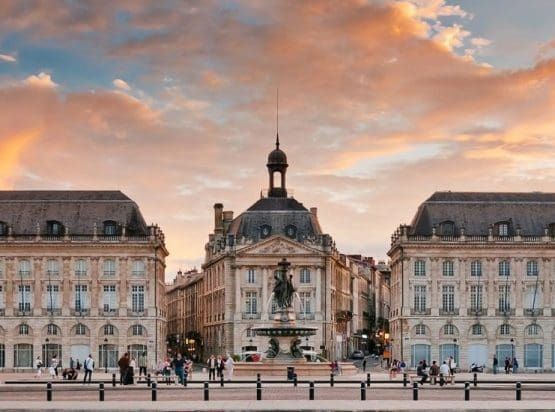
EXPLORE ALL OUR BORDEAUX WINE REGIONS GUIDE
Last updated: April 4, 2025
Consumers often ask if Bordeaux can produce thrilling wines at non-oligarch prices. The answer is a resounding yes; with a decade of mostly superb vintages under its belt, middle-range Bordeaux is a good hunting ground for exceptional quality at a fair price. You just have to know where to look.
Enter the Haut-Medoc. This Left Bank appellation is responsible for many of Bordeaux’s best-value red wines – typically Cabernet Sauvignon/Merlot blends with a dash of Cabernet Franc and/or Petit Verdot thrown in. There are Classified Growths, Cru Bourgeois, and humble ‘everyday’ chateaux in the Haut-Medoc.
However, remarkably, few estates are making bad or rustic wine today. Moreover, a quintet of ripe vintages – 2015, 16, 18, 19, and 20 – produced supple and seductive wines that there’s a choice to cellar or imbibe. Our advice is to drink – the 2015 and 2016s are opening up and drinking beautifully in 2024.
Discover More About French Wine
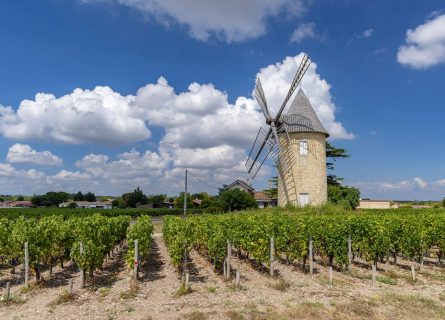
Unlike its more illustrious neighbors, fame and fortune have been slow to arrive in the Haut-Medoc. Outright snobbery plays a part, as Haut-Medoc has far fewer classified estates than Pauillac, Margaux, and St-Julien.
Nevertheless, this expansive region boasts five Classed Growths recognized in the legendary 1855 ranking undertaken by the merchants of Bordeaux. They are Chateau La Lagune, La Tour Carnet, Belgrave, Cantemerle and Camensac.
From Marshland to Vineyard
Yet viticulture has been part of the Bordeaux economy since the days of the ancient Romans, becoming internationally renowned in the Middle Ages following the marriage of Eleanor of Aquitaine and King Henry II of England. However, the bulk of the vineyards at this point in history surrounded the city of Bordeaux – the Medoc was nothing more than a mosquito-ridden swamp.
Its salvation occurred in the 17th century, when Flemish engineers drained the salt marshes of the Medoc Peninsula, which allowed vines to be planted in the gravel-rich soils they uncovered.
Standing in the shadow of La Lagune, with its dense forest revealing a handsome chateau, we can imagine the excitement of the first owners, who had developed some of the finest gravel terroirs in Bordeaux. However, the cépage (varieties planted) would be unrecognizable today; large volumes of Malbec and Carmenere were cultivated in the Medoc until the late 1800s.
Adaptation and Recognition
Then phylloxera ravaged the vineyards of Bordeaux, devastating crops in both the Left and Right Banks. The only solution was to regraft European vines onto American rootstock. This process led to the marginalization of Malbec and the growth of Merlot and Cabernet Sauvignon in the land north of Bordeaux. However, the region’s seminal moment took place in 1932 when it awarded over 200 estates the rank of Cru Bourgeois, Cru Bourgeois Supérieurs, and Cru Bourgeois exceptionnels.
Organized by the Bordeaux Chamber of Commerce and the Gironde Chamber of Agriculture, the classification was designed to elevate quality-orientated producers who were ignored by the 1855 ranking. Yet it became controversial in the 21st century, eventually annulled in 2007. Today, it has returned with force, actively promoting the numerous excellent wines produced in the Haut-Medoc.
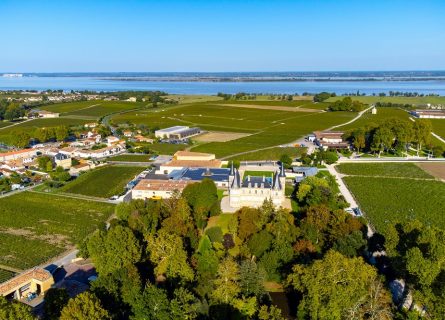
The Haut-Medoc is the second-largest appellation in the Medoc Peninsula, encompassing over 4600 hectares of vineyards north of Bordeaux. The critical mass of vines are planted in the southern and central parts of the peninsula, occasionally adjacent to famous zones like Pauillac and Margaux. Indeed, the gravel croupes (small hills) that are so effective at ripening Cabernet Sauvignon in this maritime climate are also found throughout the Haut-Medoc.
That said, many of the vineyards are located further inland and are therefore denied the moderating influences of the Gironde estuary; spring frosts and delayed ripening are more common here.
Outperforming Prestigious Neighbors
However, the region has enjoyed a string of excellent vintages in recent years, producing concentrated and voluptuous wines that invoke the best of Pauillac and Saint-Julien. Even properties, such as Sociando-Mallet, routinely outscore their Classified Growth equivalents in blind tastings. Therefore, the best chateaux of the Haut-Medoc remain the undisputed Bordeaux bargains of the 21st century.
The Complexity of Terroir
Of course, not every estate can reach the dizzying heights of Sociando-Mallet. Terroir accounts for much of the variance in quality, with the Haut-Medoc consisting of highly heterogeneous vineyards. The highest-potential sites are typically located in the communes of Saint-Laurent, Macau, and Ludon. The latter is home to the celebrated Chateau La Lagune, which typically uses at least 60% Cabernet Sauvignon in the blend, occasionally rising to over 70%.
This is sensible: Cabernet thrives on the gravel soils of the southern reaches of the Haut-Medoc, as it does in the exceptional terroirs of St-Seurin-de-Cadourne.
Finding the Right Grape for Each Terroir
Yet vineyards to the west of Pauillac boast a cooler mesoclimate and a higher clay content. Cabernet Sauvignon does not usually dominate these areas, with some notable exceptions. But Merlot will thrive on the colder clay and sandy soils of the western Haut-Medoc, yielding supple reds of good color and weight.
Pinpointing individual communes and subzones as inherently superior to their neighbors is challenging in Bordeaux, where the human touch plays a crucial role. Thus, uncompromising terroirs can deliver very good (if seldom exceptional) wines, and mistakes in the cellar can sully the finest sites.
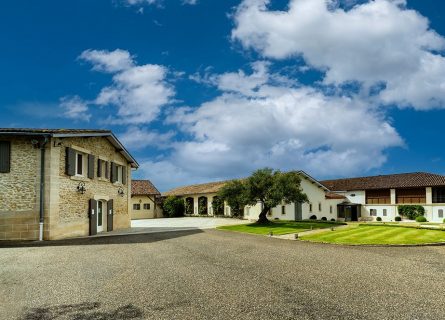
Like any appellation, the quality of wine produced in the Haut-Medoc will vary depending on the terroir and skill of the oenologist. You will also encounter different approaches to winemaking and maceration/extraction in the zone, running the whole gamut from traditional quick vinifications in wooden vats to temperature-controlled fermentation in stainless steel and extended post-fermentation maceration, often combined with long hang times. This technique produces a very concentrated and intense style of Bordeaux red, although it will not be to everyone’s taste.
Tradition of Blending
However, there are red lines that few dare to cross. For one thing, it is very rare to taste a single-varietal wine in the Haut-Medoc; blending different varieties has been the tradition here for centuries and is unlikely to die out soon. This is partly for commercial reasons: as one variety fails to ripen properly, vignerons can focus their efforts on making a decent blend from earlier-ripening grapes like Merlot and Cabernet Franc. The latter brings freshness and perfume to the wine, while Merlot contributes fruit and texture.
Petit Verdot is also gaining ground in the Haut-Medoc, appreciated for its spicy aroma and good grip. A tiny volume of white is also made here. However, it is only entitled to the appellation Bordeaux Blanc.
Merlot Versus Cabernet Dominance
In broad strokes, there are two categories of Haut-Medoc: red wines that place Merlot at the heart of the blend and bottles that contain at least 65-70 percent Cabernet Sauvignon. Chateau Cambon La Pelouse is one estate renowned for its Merlot-dominant wines, matured in 40 percent new wood for about 14 months. The results in bottle are rich and concentrated, marked by toasty oak with a lush and fruity palate. The tannins are often quite ripe and silky, approachable from a young age.
This stands in marked contrast to the prevailing style at Chateau Cissac. Bordeaux traditionalists strongly regard the property, often describing it as a “classic” claret. They are spot on: Cissac uses at least 70% Cabernet Sauvignon in the blend, fashioning a structured and muscular beast (at least in its youth) that requires a few years in bottle to soften.
Your patience will yield a supremely elegant and complex red wine filled with notes of cassis, tobacco, cedar, and leather. Nevertheless, not everyone can handle the occasionally brutal tannic structure of Cissac. They will find solace in Chateau La Tour-Carnet’s plumper, richer wines – fleshly, opulent, and unashamedly modern in style.
Over 230 individual wine producers represent the Haut-Medoc, creating a buyer’s market. You’ll find up-and-coming chateaux, long-established names, and ambitious young winemakers within that mix. There are small family-run businesses on the brink of bankruptcy and estates owned by cash-rich multinationals. Therefore, the choice on offer can sometimes be a little overwhelming. In that scenario, a bit of insider knowledge can go a long way.
Navigating the Classifications
One of the best starting points is the official classification of the chateau. In addition to the five properties recognized in the 1855 classification, the Haut-Medoc boasts over 45 wineries awarded Cru Bourgeois status. Nonetheless, this important framework has encountered more trials and tribulations than any Bordeaux classification. Indeed, even the sometimes controversial Saint-Emilion hierarchy cannot compete with the politics of the Cru Bourgeois!
The Evolution and Impact of the ‘Cru Bourgeois’ Designation
The term ‘Cru Bourgeois’ has been in use since the 1800s – an unregulated piece of marketing that was unfortunately abused by (some) unscrupulous owners desperate to improve the reputation of their mediocre wines.
However, after several debates and arguments, the initiative was given official status during a reclassification in 2003. Yet this landmark project to codify the Cru Bourgeois saw many properties ejected from the scheme: 247 out of 490 candidates made the grade. They were classified as Crus Bourgeois, Crus Bourgeois Supérieurs, and Crus Bourgeois Exceptionnels. Cue a series of court cases and their annulment in 2007. Thankfully, the category was reintroduced in 2010 and updated in 2020.
Read more about the Cru Bourgeois classification
Crus Artisans
Today, it remains a reliable guide to quality in the Haut-Medoc, much like the Cru Artisan moniker. This little-known title refers to a 19th-century tradition of calling chateaux owned by Bordeaux tradespeople – blacksmiths, coopers, and carpenters – ‘Cru Artisan.’ An organization called the Syndicat des Crus Artisans du Médoc represents this small (but growing) firmament of winemakers, including Chateau Pey Mallet in the Haut-Médoc. The criteria for entry are strict: wines are tasted blind by a panel of experts, who must be satisfied that the estate is made of the right stuff. It is fair, democratic, and, dare we say it, perhaps a more reliable benchmark than the 1855 ranking, left unchanged (bar one exception) for over 170 years.
Read more about the Crus Artisans du Medoc Classification
The sauvignon blanc grape varietal, originally from the Bordeaux region of France, is now one of the world's most loved white varieties.
Find out moreExplore the allure of the Semillon grape & its legendary connection to Sauternes. Unveil the history & flavors of this captivating varietal. Cheers!
Find out moreCabernet Franc grape is a close relative of Merlot and Cabernet Sauvignon and is the principal blending grape used in Bordeaux.
Find out moreDiscover the irresistible allure of Cabernet Sauvignon—a worldwide favorite with robust, dark-bodied flavor. Unleash your wine journey today!
Find out moreMerlot is the most cultivated grape in Bordeaux and closely related to Cabernet Franc
Find out morePetit Verdot is a full-bodied red wine grape varietal used in classic Bordeaux blends and originates in southwestern France
Find out more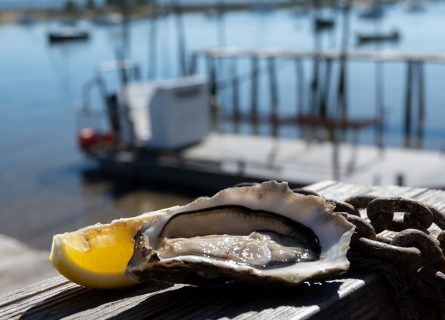
The restaurants of the Medoc Peninsula are quite different from the glitz and glamor of downtown Bordeaux. Here, in the timeless and serene villages of the Haut-Medoc, you’ll encounter honest food prepared in family-run kitchens, often featuring landmark ingredients like salt marsh lamb, magaret de canard (duck breast), and oysters from the Gironde. Follow the waiter’s recommendations, and you can’t go far wrong.
A Guide to the gastronomy and Cuisine of Bordeaux: Read more

Uncover Bordeaux's vibrant flavors and culinary gems with our expert guides. Plan an unforgettable trip now!
Read more
Uncover Arcachon vibrant flavors and culinary gems with our expert guides. Plan an unforgettable trip now!
Read more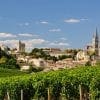
Uncover Saint Emilion's vibrant flavors and culinary gems with our expert guides. Plan an unforgettable trip now!
Read moreIf you would like us to customize an exclusive luxury tour, contact us and let us know your travel plans. We offer luxury food and wine tours for private groups of a mininium two guests. In addition, all of our private, chauffeured tours are available year-round upon request.

